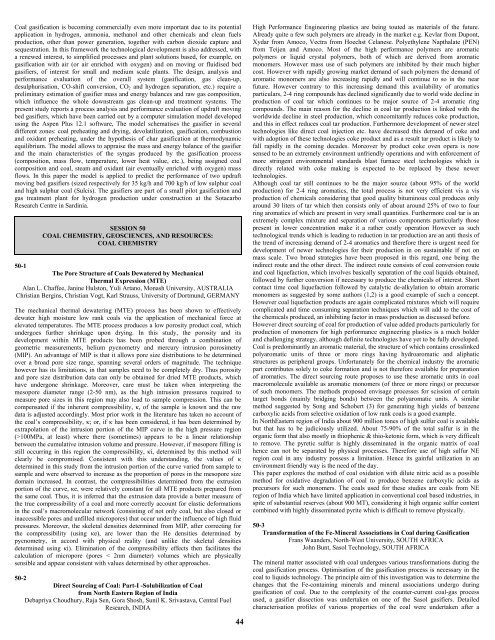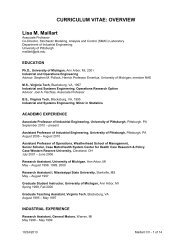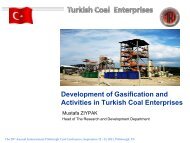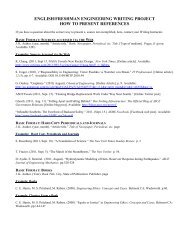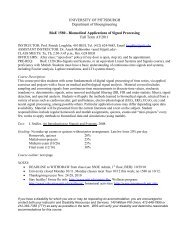Abstract Booklet 2006 - Swanson School of Engineering - University ...
Abstract Booklet 2006 - Swanson School of Engineering - University ...
Abstract Booklet 2006 - Swanson School of Engineering - University ...
Create successful ePaper yourself
Turn your PDF publications into a flip-book with our unique Google optimized e-Paper software.
Coal gasification is becoming commercially even more important due to its potential<br />
application in hydrogen, ammonia, methanol and other chemicals and clean fuels<br />
production, other than power generation, together with carbon dioxide capture and<br />
sequestration. In this framework the technological development is also addressed, with<br />
a renewed interest, to simplified processes and plant solutions based, for example, on<br />
gasification with air (or air enriched with oxygen) and on moving or fluidised bed<br />
gasifiers, <strong>of</strong> interest for small and medium scale plants. The design, analysis and<br />
performance evaluation <strong>of</strong> the overall system (gasification, gas clean-up,<br />
desulphurisation, CO-shift conversion, CO 2 and hydrogen separation, etc.) require a<br />
preliminary estimation <strong>of</strong> gasifier mass and energy balances and raw gas composition,<br />
which influence the whole downstream gas clean-up and treatment systems. The<br />
present study reports a process analysis and performance evaluation <strong>of</strong> updraft moving<br />
bed gasifiers, which have been carried out by a computer simulation model developed<br />
using the Aspen Plus 12.1 s<strong>of</strong>tware, The model schematises the gasifier in several<br />
different zones: coal preheating and drying, devolatilization, gasification, combustion<br />
and oxidant preheating, under the hypothesis <strong>of</strong> char gasification at thermodynamic<br />
equilibrium. The model allows to appraise the mass and energy balance <strong>of</strong> the gasifier<br />
and the main characteristics <strong>of</strong> the syngas produced by the gasification process<br />
(composition, mass flow, temperature, lower heat value, etc.), being assigned coal<br />
composition and coal, steam and oxidant (air eventually enriched with oxygen) mass<br />
flows. In this paper the model is applied to predict the performance <strong>of</strong> two updraft<br />
moving bed gasifiers (sized respectively for 35 kg/h and 700 kg/h <strong>of</strong> low sulphur coal<br />
and high sulphur coal (Sulcis). The gasifiers are part <strong>of</strong> a small pilot gasification and<br />
gas treatment plant for hydrogen production under construction at the Sotacarbo<br />
Research Centre in Sardinia.<br />
SESSION 50<br />
COAL CHEMISTRY, GEOSCIENCES, AND RESOURCES:<br />
COAL CHEMISTRY<br />
50-1<br />
The Pore Structure <strong>of</strong> Coals Dewatered by Mechanical<br />
Thermal Expression (MTE)<br />
Alan L. Chaffee, Janine Hulston, Yuli Artano, Monash <strong>University</strong>, AUSTRALIA<br />
Christian Bergins, Christian Vogt, Karl Strauss, <strong>University</strong> <strong>of</strong> Dortmund, GERMANY<br />
The mechanical thermal dewatering (MTE) process has been shown to effectively<br />
dewater high moisture low rank coals via the application <strong>of</strong> mechanical force at<br />
elevated temperatures. The MTE process produces a low porosity product coal, which<br />
undergoes further shrinkage upon drying. In this study, the porosity and its<br />
development within MTE products has been probed through a combination <strong>of</strong><br />
geometric measurements, helium pycnometry and mercury intrusion porosimetry<br />
(MIP). An advantage <strong>of</strong> MIP is that it allows pore size distributions to be determined<br />
over a broad pore size range, spanning several orders <strong>of</strong> magnitude. The technique<br />
however has its limitations, in that samples need to be completely dry. Thus porosity<br />
and pore size distribution data can only be obtained for dried MTE products, which<br />
have undergone shrinkage. Moreover, care must be taken when interpreting the<br />
mesopore diameter range (2-50 nm), as the high intrusion pressures required to<br />
measure pore sizes in this region may also lead to sample compression. This can be<br />
compensated if the inherent compressibility, κ, <strong>of</strong> the sample is known and the raw<br />
data is adjusted accordingly. Most prior work in the literature has taken no account <strong>of</strong><br />
the coal’s compressibility, κ; or, if κ has been considered, it has been determined by<br />
extrapolation <strong>of</strong> the intrusion portion <strong>of</strong> the MIP curve in the high pressure region<br />
(>100MPa, at least) where there (sometimes) appears to be a linear relationship<br />
between the cumulative intrusion volume and pressure. However, if mesopore filling is<br />
still occurring in this region the compressibility, κi, determined by this method will<br />
clearly be compromised. Consistent with this understanding, the values <strong>of</strong> κ<br />
determined in this study from the intrusion portion <strong>of</strong> the curve varied from sample to<br />
sample and were observed to increase as the proportion <strong>of</strong> pores in the mesopore size<br />
domain increased. In contrast, the compressibilities determined from the extrusion<br />
portion <strong>of</strong> the curve, κe, were relatively constant for all MTE products prepared from<br />
the same coal. Thus, it is inferred that the extrusion data provide a better measure <strong>of</strong><br />
the true compressibility <strong>of</strong> a coal and more correctly account for elastic deformations<br />
in the coal’s macromolecular network (consisting <strong>of</strong> not only coal, but also closed or<br />
inaccessible pores and unfilled micropores) that occur under the influence <strong>of</strong> high fluid<br />
pressures. Moreover, the skeletal densities determined from MIP, after correcting for<br />
the compressibility (using κe), are lower than the He densities determined by<br />
pycnometry, in accord with physical reality (and unlike the skeletal densities<br />
determined using κi). Elimination <strong>of</strong> the compressibility effects then facilitates the<br />
calculation <strong>of</strong> micropore (pores < 2nm diameter) volumes which are physically<br />
sensible and appear consistent with values determined by other approaches.<br />
50-2<br />
Direct Sourcing <strong>of</strong> Coal: Part-I -Solubilization <strong>of</strong> Coal<br />
from North Eastern Region <strong>of</strong> India<br />
Debapriya Choudhury, Raja Sen, Gora Shosh, Sunil K. Srivastava, Central Fuel<br />
Research, INDIA<br />
44<br />
High Performance <strong>Engineering</strong> plastics are being touted as materials <strong>of</strong> the future.<br />
Already quite a few such polymers are already in the market e.g. Kevlar from Dupont,<br />
Xydar from Amoco, Vectra from Hoechst Celanese. Polyethylene Napthalate (PEN)<br />
from Teijen and Amoco. Most <strong>of</strong> the high performance polymers are aromatic<br />
polymers or liquid crystal polymers, both <strong>of</strong> which are derived from aromatic<br />
monomers. However mass use <strong>of</strong> such polymers are inhibited by their much higher<br />
cost. However with rapidly growing market demand <strong>of</strong> such polymers the demand <strong>of</strong><br />
aromatic monomers are also increasing rapidly and will continue to so in the near<br />
future. However contrary to this increasing demand this availability <strong>of</strong> aromatics<br />
particulars, 2-4 ring compounds has declined significantly due to world wide decline in<br />
production <strong>of</strong> coal tar which continues to be major source <strong>of</strong> 2-4 aromatic ring<br />
compounds. The main reason for the decline in coal tar production is linked with the<br />
worldwide decline in steel production, which concomitantly reduces coke production,<br />
and this in effect reduces coal tar production. Furthermore development <strong>of</strong> newer steel<br />
technologies like direct coal injection etc. have decreased this demand <strong>of</strong> coke and<br />
with adoption <strong>of</strong> these technologies coke product and as a result tar product is likely to<br />
fall rapidly in the coming decades. Moreover by product coke oven opera is now<br />
sensed to be an extremely environment unfriendly operations and with enforcement <strong>of</strong><br />
more stringent environmental standards blast furnace steel technologies which is<br />
directly related with coke making is expected to be replaced by these newer<br />
technologies.<br />
Although coal tar still continues to be the major source (about 95% <strong>of</strong> the world<br />
production) for 2-4 ring aromatics, the total process is not very efficient vis a vis<br />
production <strong>of</strong> chemicals considering that good quality bituminous coal produces only<br />
around 30 liters <strong>of</strong> tar which then consists only <strong>of</strong> about around 25% <strong>of</strong> two to four<br />
ring aromatics <strong>of</strong> which are present in very small quantities. Furthermore coal tar is an<br />
extremely complex mixture and separation <strong>of</strong> various components particularly those<br />
present in lower concentration make it a rather costly operation However as such<br />
technological trends which is leading to reduction in tar production are an anti thesis <strong>of</strong><br />
the trend <strong>of</strong> increasing demand <strong>of</strong> 2-4 aromatics and therefore there is urgent need for<br />
development <strong>of</strong> newer technologies for their production in on sustainable if not on<br />
mass scale. Two broad strategies have been proposed in this regard, one being the<br />
indirect route and the other direct. The indirect route consists <strong>of</strong> coal conversion route<br />
and coal liquefaction, which involves basically separation <strong>of</strong> the coal liquids obtained,<br />
followed by further conversion if necessary to produce the chemicals <strong>of</strong> interest. Short<br />
contact time coal liquefaction followed by catalytic de-alkylation to obtain aromatic<br />
monomers as suggested by some authors (1,2) is a good example <strong>of</strong> such a concept.<br />
However coal liquefaction products are again complicated mixtures which will require<br />
complicated and time consuming separation techniques which will add to the cost <strong>of</strong><br />
the chemicals produced, an inhibiting factor in mass production as discussed before.<br />
However direct sourcing <strong>of</strong> coal for production <strong>of</strong> value added products particularly for<br />
production <strong>of</strong> monomers for high performance engineering plastics is a much bolder<br />
and challenging strategy, although definite technologies have yet to be fully developed.<br />
Coal is predominantly an aromatic material, the structure <strong>of</strong> which contains crosslinked<br />
polyaromatic units <strong>of</strong> three or more rings having hydroaromatic and aliphatic<br />
structures as peripheral groups. Unfortunately for the chemical industry the aromatic<br />
part contributes solely to coke formation and is not therefore available for preparation<br />
<strong>of</strong> aromatics. The direct sourcing route proposes to use these aromatic units in coal<br />
macromolecule available as aromatic monomers (<strong>of</strong> three or more rings) or precursor<br />
<strong>of</strong> such monomers. The methods proposed envisage processes for scission <strong>of</strong> certain<br />
target bonds (mainly bridging bonds) between the polyaromatic units. A similar<br />
method suggested by Song and Schobert (3) for generating high yields <strong>of</strong> benzene<br />
carboxylic acids from selective oxidation <strong>of</strong> low rank coals is a good example.<br />
In NorthEastern region <strong>of</strong> India about 900 million tones <strong>of</strong> high sulfur coal is available<br />
but that has to be judiciously utilized. About 75-90% <strong>of</strong> the total sulfur is in the<br />
organic form that also mostly in thiophenic & thio-ketonic form, which is very difficult<br />
to remove. The pyretic sulfur is highly disseminated in the organic matrix <strong>of</strong> coal<br />
hence can not be separated by physical processes. Therefore use <strong>of</strong> high sulfur NE<br />
region coal in any industry possess a limitation. Hence its gainful utilization in an<br />
environment friendly way is the need <strong>of</strong> the day.<br />
This paper explores the method <strong>of</strong> coal oxidation with dilute nitric acid as a possible<br />
method for oxidative degradation <strong>of</strong> coal to produce benzene carboxylic acids as<br />
precursors for such monomers. The coals used for these studies are coals from NE<br />
region <strong>of</strong> India which have limited application in conventional coal based industries, in<br />
spite <strong>of</strong> substantial reserves (about 900 MT), considering it high organic sulfur content<br />
combined with highly disseminated pyrite which is difficult to remove physically.<br />
50-3<br />
Transformation <strong>of</strong> the Fe-Mineral Associations in Coal during Gasification<br />
Frans Waanders, North-West <strong>University</strong>, SOUTH AFRICA<br />
John Bunt, Sasol Technology, SOUTH AFRICA<br />
The mineral matter associated with coal undergoes various transformations during the<br />
coal gasification process. Optimisation <strong>of</strong> the gasification process is necessary in the<br />
coal to liquids technology. The principle aim <strong>of</strong> this investigation was to determine the<br />
changes that the Fe-containing minerals and mineral associations undergo during<br />
gasification <strong>of</strong> coal. Due to the complexity <strong>of</strong> the counter-current coal-gas process<br />
used, a gasifier dissection was undertaken on one <strong>of</strong> the Sasol gasifiers. Detailed<br />
characterisation pr<strong>of</strong>iles <strong>of</strong> various properties <strong>of</strong> the coal were undertaken after a


